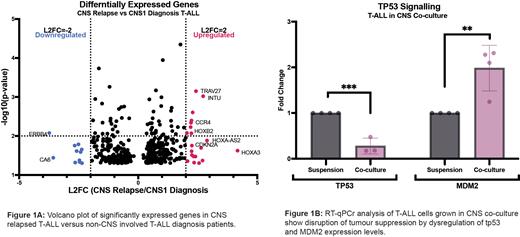Although modern treatment has improved the overall survival of pediatric T-cell acute lymphoblastic leukemia (T-ALL) greatly, more than 20% of all children diagnosed with T-ALL relapse (Fattizzo et al., 2020). Approximately 30% of all relapse cases occur in the central nervous system (CNS) and CNS involvement is considered a major risk factor for treatment failure and increased mortality (Frishman-Levy & Izraeli, 2017). To date, CNS directed therapy is considered essential for complete cure to prevent relapse in the CNS, leading to severe neurotoxic effects and long-term adverse complications (Thastrup et al., 2022). Due to lack of knowledge regarding the mechanisms promoting leukemia survival in the CNS and absence of reliable biomarkers to predict CNS involvement, the development of new therapeutic drugs able to eradicate leukemia cells in the CNS is not progressing, therefor limiting the overall survival of pediatric T-ALL patients (Thastrup et al., 2022).
To identify genetic alterations in CNS involved T-ALL we performed an RNA-sequencing analysis coupled with a gene set enrichment analysis (GSEA) studying pediatric T-ALL patient samples obtained from the TARGET initiative. We included 30 samples from patients at initial diagnosis subdivided by degree of CNS involvement, ranging from CNS1 (no CNS disease) to CNS3 (advanced CNS disease), as well as 13 samples from patients who had relapsed in the CNS. Our analysis identified distinct genetic alterations in CNS involved T-ALL and CNS relapse compared to diagnosis samples without CNS implications, with dysregulation of genes involved in tumour suppression, apoptosis and self-renewal. CNS relapsed patients were distinguished from diagnosis patients by a distinct gene expression pattern, with an upregulation of many genes, including cell cycle inhibitor CDKN2A and transcription factor HOXA3 (Figure 1A). We also found disruption of many signaling pathways, including enrichment of the p53 pathway in patients who relapsed in the CNS compared to non-CNS involved diagnosis patients.
To further study the effects of CNS implications in pediatric T-ALL, we established a co-culture of pediatric T-ALL cell lines (n=4) and a glioblastoma cell line (U87-MG). Following co-culture, changes to mRNA expression was evaluated by RT-qPCR, revealing dysregulation of many genes, including an upregulation of cancer stem cell marker and cell adhesion molecule CD44 (Chen et al., 2018). Moreover, T-ALL cells grown in CNS co-culture displayed a downregulation of tumour suppressor TP53 and an upregulation of its negative regulator, proto-oncogene MDM2 when compared to cells grown in suspension (Figure 1B) (Hernandez Borrero & El-Deiry, 2021). Co-culture also induced pro-survival isoform switching of BCL2L1 (BCLX), part of the BCL family of apoptotic regulators (Daniel et al., 2013). Together, these results suggest an increased survival and loss of tumour suppression of T-ALL cells when grown in direct contact with CNS derived cells.
To determine effects of the CNS microenvironment on therapy resistance, T-ALL cell lines grown in co-culture were exposed to 2µM methotrexate, a chemotherapeutic agent used during CNS directed therapy (Thastrup et al., 2022). Leukemia cells in co-culture displayed an increased survival compared to cells grown in suspension following 48 hours of methotrexate exposure, as well as dysregulation of several genes involved in cell survival, self-renewal and cell cycle regulation. Cyclins and CDKs involved in controlling cell cycle progression were differentially expressed in co-culture versus suspension, with a downregulation of CDK2 and cyclin A, crucial for S/G2 transition, as well as CDK1 and cyclin B, responsible for G2/M transition (Leal-Esteban & Fajas, 2020). These results indicate a shift towards cell cycle arrest and senescence of T-ALL cells during methotrexate exposure in CNS co-culture, potentially promoting leukemia survival and chemoresistance.
Taken together, our findings indicate a differential gene expression pattern in CNS involved T-ALL, which could potentially be utilized as predicative biomarkers to properly identify patients at risk of CNS relapse. CNS co-culture revealed cell cycle alterations and loss of proliferation markers, promoting senescence and therapy resistance, which could serve as potential therapeutic targets.
Disclosures
No relevant conflicts of interest to declare.


